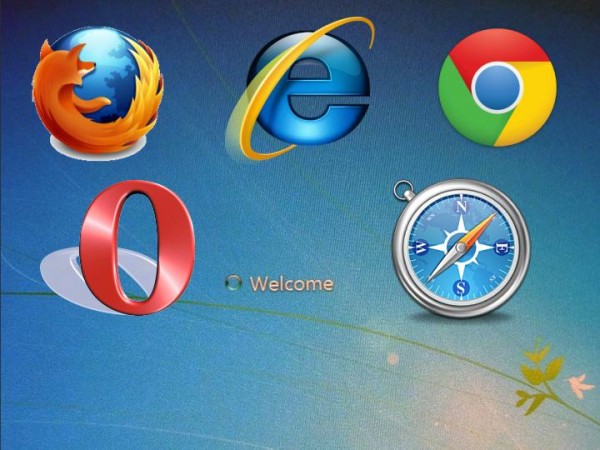 In 2009, the European Commission investigated Microsoft’s practice of bundling its own browser, Internet Explorer, with new copies of Windows. It found that this was an abuse of market power and created an unfair barrier to entry of other browsers, such as Firefox.
In 2009, the European Commission investigated Microsoft’s practice of bundling its own browser, Internet Explorer, with new copies of Windows. It found that this was an abuse of market power and created an unfair barrier to entry of other browsers, such as Firefox.
An agreement was reached that Microsoft would include a ‘choice screen’ in which users in the EU would be given a full list of alternative browsers and asked which they would like to install. On making their selection, a link would take them to the browser site to download the installation program. This screen would be available until 2014. Between March 2010, when the choice screen was first provided and November of the same year, 84 million browsers were downloaded through it.
In May 2011, however, the screen was no longer present on new Windows 7 purchases. The Commission took some time to realise this: indeed it was Microsoft’s rivals that pointed it out. The screen reappeared some 13 months later, after some 15m copies of Windows software had been sold.
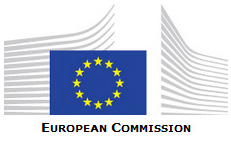 For this lapse, the Commission has just fined Microsoft €561m. Commission Vice President in charge of competition policy, Joaquín Almunia, said:
For this lapse, the Commission has just fined Microsoft €561m. Commission Vice President in charge of competition policy, Joaquín Almunia, said:
In 2009, we closed our investigation about a suspected abuse of dominant position by Microsoft due to the tying of Internet Explorer to Windows by accepting commitments offered by the company. Legally binding commitments reached in antitrust decisions play a very important role in our enforcement policy because they allow for rapid solutions to competition problems. Of course, such decisions require strict compliance. A failure to comply is a very serious infringement that must be sanctioned accordingly.
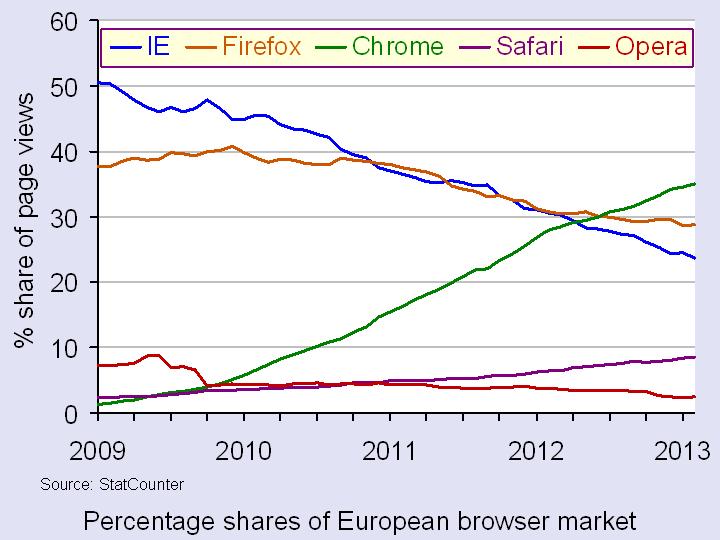 This may seem unduly harsh, given that Internet Explorer’s share of the browser market has fallen dramatically. In 2009, it had around 50% of the European market, with its main rival at the time, Mozilla’s Firefox, having just under 40%. By 2013, Internet Explorer’s share has fallen to around 24% and Firefox’s to around 29%. Google’s Chrome, which was just starting up in 2009, has seen its share of the European market rise to around 35% and is now the market leader. Partly this is due to the rise in tablets and smartphones, a large proportion of which use Google’s Android operating system and the Chrome browser.
This may seem unduly harsh, given that Internet Explorer’s share of the browser market has fallen dramatically. In 2009, it had around 50% of the European market, with its main rival at the time, Mozilla’s Firefox, having just under 40%. By 2013, Internet Explorer’s share has fallen to around 24% and Firefox’s to around 29%. Google’s Chrome, which was just starting up in 2009, has seen its share of the European market rise to around 35% and is now the market leader. Partly this is due to the rise in tablets and smartphones, a large proportion of which use Google’s Android operating system and the Chrome browser.
Not surprisingly, the European Commission is investigating Google to see whether it is abusing a dominant position. Is Google’s case, it’s not just about its share of the browser market, it’s more about its share of the search market, which in the EU is around 90% (compared with around 65% in the USA). As The Economist article below states:
The Commissioner believes that Google may be favouring its own specialised services (eg, for flights or hotels) at rivals’ expense; that its deals with publishers may unfairly exclude competitors; and that it prevents advertisers from taking their data elsewhere.
Joaquín Almunia asked Google to respond to these concerns by January 31. Google delivered its suggestions on the deadline, but we await to hear precisely what it said and how the Commission will respond. It is understood that Google’s proposal is for clearly labelling its own products on its search engine.
Articles
Microsoft Fined $732 Million By EU Over Browser eWeek, Michelle Maisto (6/3/13)
Microsoft faces hefty EU fine The Guardian (6/3/13)
Sin of omission The Economist (9/3/13)
Microsoft fined by European Commission over web browser BBC News (6/3/13)
 EU commissioner Joaquin Almunia announces Microsoft fine BBC News (6/3/13)
EU commissioner Joaquin Almunia announces Microsoft fine BBC News (6/3/13)
Microsoft’s European Fine Comes in an Era of Browser Diversity Forbes, J.P. Gownder (6/3/13)
Life after Firefox: Can Mozilla regain its mojo? BBC News, Dave Lee (11/4/12)
Google responds to European commission’s antitrust chief The Guardian, Charles Arthur (31/1/13)
Google May Clinch EU Settlement After ‘Summer,’ Almunia Says Bloomberg Businessweek, Stephanie Bodoni and Aoife White (22/2/13)
European Commission Press Release
Antitrust: Commission fines Microsoft for non-compliance with browser choice commitments Europa (6/3/13)
Questions
- Why did Microsoft’s share of the browser market continue to decline between May 2011 and June 2012?
- Why would it matter if Microsoft had market power in the browser market, given that it’s free for anyone to download a browser?
- In what ways might Google be abusing a dominant position in the market?
- Can Mozilla regain its mojo?
- According to the second Guardian article, the Microsoft-backed lobby group Icomp said “To be seen as a success, any settlement must … include specific measures to restore competition and allow other parties to compete effectively on a level playing field with Google in the key markets of search and search advertising.” Give examples of such measures and assess how successful they might be.
- Would “clearly labelling its own products on its search engine” be enough to ensure adequate competition?
 Six of the major tea producing countries – India, Kenya, Sri Lanka, Indonesia, Rwanda and Malawi – have formed an International Tea Producers’ Forum (ITPF). Together these countries produce slightly more than the world’s tea. The hope of the members of the new ITPF is that their cartel will allow them to increase the price of tea to the growers and to create greater price stability.
Six of the major tea producing countries – India, Kenya, Sri Lanka, Indonesia, Rwanda and Malawi – have formed an International Tea Producers’ Forum (ITPF). Together these countries produce slightly more than the world’s tea. The hope of the members of the new ITPF is that their cartel will allow them to increase the price of tea to the growers and to create greater price stability.
According to the Assam Tribune article below:
ITPF’s main objectives include – safeguarding the interests of the tea-producing countries, evolving collective solutions for the problems facing the producers, providing technical cooperation, sharing of technology and expertise by the member countries, undertaking market studies and research projects to address any specific issues concerning tea in general or any variety of tea, among others.
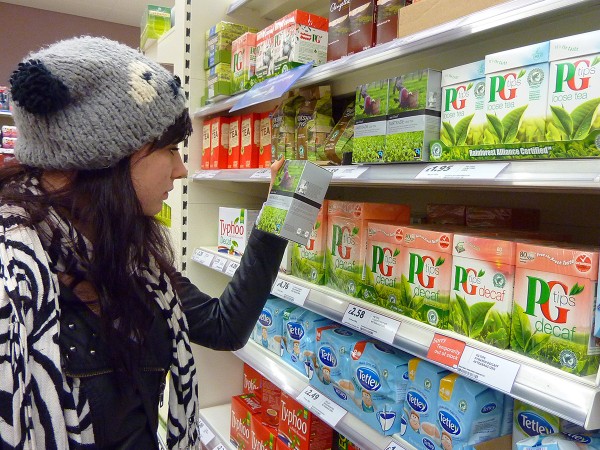 And according to the article from Sri Lanka’s Daily News:
And according to the article from Sri Lanka’s Daily News:
Chairman of the Planters’ Association of Ceylon, which represents the interests of 23 Regional Plantation Companies, Lalith Obeyesekere said this was a landmark occasion. Sri Lanka particularly looks to the forum to provide long-term sustainability to the tea industry in maintaining price stability and quality standards, among the other objectives set out in the mandate… The Planters’ Association said they were confident that Sri Lanka could use the ITPF to re-look at the industry in order that local tea producers realize their full potential.
Sri Lanka’s plantation industries minister Mahinda Samarasinghe said:
The bulk of production is in the hands of smallholders. So there’s a need to increase their incomes. Price stability is definitely important.
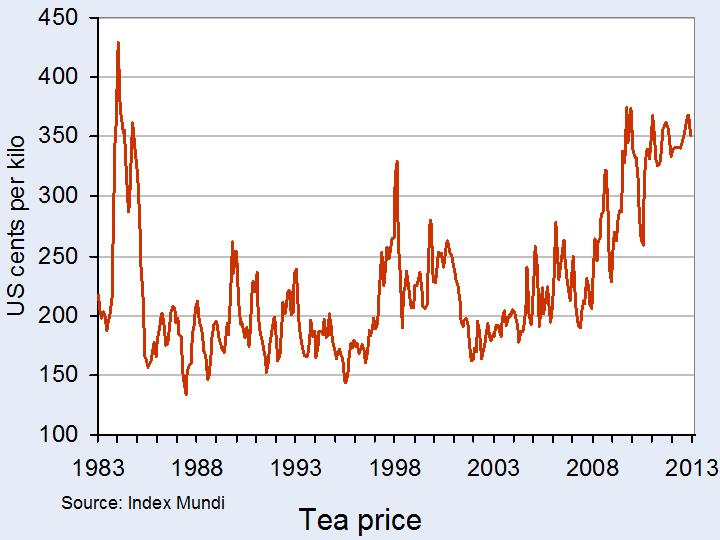 The main aim of the ITPF over the longer term is likely to be to raise tea prices. The chart shows international tea prices from 1983 to the present day. As you can see, they have fluctuated considerably. Note that these are prices in nominal terms and hence do not take inflation into account. Click here for a PowerPoint of the chart.
The main aim of the ITPF over the longer term is likely to be to raise tea prices. The chart shows international tea prices from 1983 to the present day. As you can see, they have fluctuated considerably. Note that these are prices in nominal terms and hence do not take inflation into account. Click here for a PowerPoint of the chart.
But if the main aim is to increase prices to tea growers, how could this be achieved? One objective of the ITPF is to stimulate demand for tea by ‘promoting tea consumption through generic promotional campaigns’. The aim would be to encourage people to switch from coffee and soft drinks.
 But to take advantage of its market power, the cartel might also want to reduce tea production, thereby pushing up the price. This, of course, would be more feasible if it had a larger than 50% share of the market.
But to take advantage of its market power, the cartel might also want to reduce tea production, thereby pushing up the price. This, of course, would be more feasible if it had a larger than 50% share of the market.
Although production quotas are not currently part of the agreement, these are likely to be considered at future meetings, especially if the three other large producers – China, Vietnam and Iran – can be persuaded to join.
China, with some 38% of the market, is the world’s largest tea producer. Although it sent an observer to the meeting (as did Iran), it was not one of the signatories. If it could be persuaded to join the cartel, this would increase its power. Nevertheless, China specialises in different types of tea, mainly green teas, and is not the world’s biggest exporter – that is Kenya.
Articles
Tea nations join forces Radio New Zealand (25/1/13)
International Tea Producers’ Forum formed Assam Tribune, Ajit Patowary (23/1/13)
Planters’ Association upbeat on newly formed International Tea Producer’s Forum Daily News (Sri Lanka) (26/1/13)
Leaf Lobby: Sri Lanka hosts tea producer forum Lanka Business Online (24/1/13)
‘Tea cartel’ formed by biggest producing nation BBC News (23/1/13)
Tea producers brew up plan to raise prices Emirates 24/7 (23/1/13)
Data
Tea Monthly Price – US cents per Kilogram Index Mundi
Questions
- What are the stated aims of the newly formed ITPF? How realistic are they?
- What conditions are necessary for a cartel to be successful in raising prices over the long term?
- With reference to the chart, what can you say about the real price of tea over the period 1983 to 2013?
- To what extent are these conditions met by the ITPF?
- Why may a rise in tea prices in the supermarkets not result in a rise in prices to tea growers?
- How may tea growers benefit from the ITPF even if the Forum does not result directly in a rise in prices to growers?
- How can game theory help to explain the possible behaviour of members of a cartel and producers outside the cartel?
 Two of the biggest publishing companies, Pearson of the UK and Bertelsmann of Germany are to form a joint venture by merging their Penguin and Random House imprints. Bertelsmann will have a majority stake in the venture of 53% and Pearson will have 47%.
Two of the biggest publishing companies, Pearson of the UK and Bertelsmann of Germany are to form a joint venture by merging their Penguin and Random House imprints. Bertelsmann will have a majority stake in the venture of 53% and Pearson will have 47%.
The Penguin imprint, with a turnover of just over £1bn, has an 11% share of the English language book publishing market. Random House has a 15% share, with turnover of around £1.5bn. The new ‘Penguin Random House’, as it will be called, will have nearly 26% of the market, which should give it considerable market power to combat various threats in the book publishing market.
One threat is from online retailers, such as Amazon, Apple and Google, which use their countervailing power to drive down the prices they pay to publishers. Another threat is from the rise of electronic versions of books. Although e-books save on printing costs, competition is driving down prices, including the prices of paper books, which may make publishers more reluctant to publish new titles in paper form.
There has been a mixed reception from authors: some are worried that an effective reduction in the number of major publishers from six to five will make it harder to get books published and may squeeze royalty rates; others feel that an increased market power of publishers to take on the online retailers will help to protect the interests of authors
The following videos and articles look at the nature of this joint venture and its implications for costs, revenues and publishing more generally.
Videos and webcasts
 Penguin and Random House merge to take on digital giants Channel 4 News, Matthew Cain (29/10/12)
Penguin and Random House merge to take on digital giants Channel 4 News, Matthew Cain (29/10/12)
 Penguin and Random House confident merger will be approved BBC News, Will Gompertz (29/10/12)
Penguin and Random House confident merger will be approved BBC News, Will Gompertz (29/10/12)
 Penguin Books and Random House to merge BBC News, Matt Cowan (29/10/12)
Penguin Books and Random House to merge BBC News, Matt Cowan (29/10/12)
Articles
Random House and Penguin merge to take on Amazon, Apple Reuters, Kate Holton (29/10/12)
Pearson’s Penguin joins Random House Independent, Amy Thomson and Joseph de Weck (29/10/12)
Penguin and Random House sign merger deal Financial Times, Gerrit Wiesmann and Robert Budden (29/10/12)
March of the Penguin The Economist, Schumpeter blog (29/10/12)
Penguin chief: News Corp can’t derail Random House deal The Guardian, Mark Sweney (29/10/12)
Penguin and Random House confident merger will be approved BBC News, Anthony Reuben (29/10/12)
And so I bid Penguin a sad farewell Independent, Andrew Franklin (29/10/12)
Questions
- How does a joint venture differ from a merger?
- What types of economies of scale are likely to result from the joint venture?
- How are authors likely to be affected?
- Will the joint venture benefit the book reading public?
- The relationship between publishers and online retailers can be described as one of ‘bilateral oligopoly’. Explain what this means and why it is impossible to determine an ‘equilibrium’ wholesale price of books in such a market.
- What criteria would the competition authorities use to assess whether or not the joint venture should be permitted to proceed?
- What is likely to be the long-term outlook for Penguin Random House?
- Assess the benefits and costs of a News Corporation takeover of the Penguin division? This was an alternative offer to Pearson had it not gone with Bertelsmann. (News Corp. has the Harper Collins imprint.)
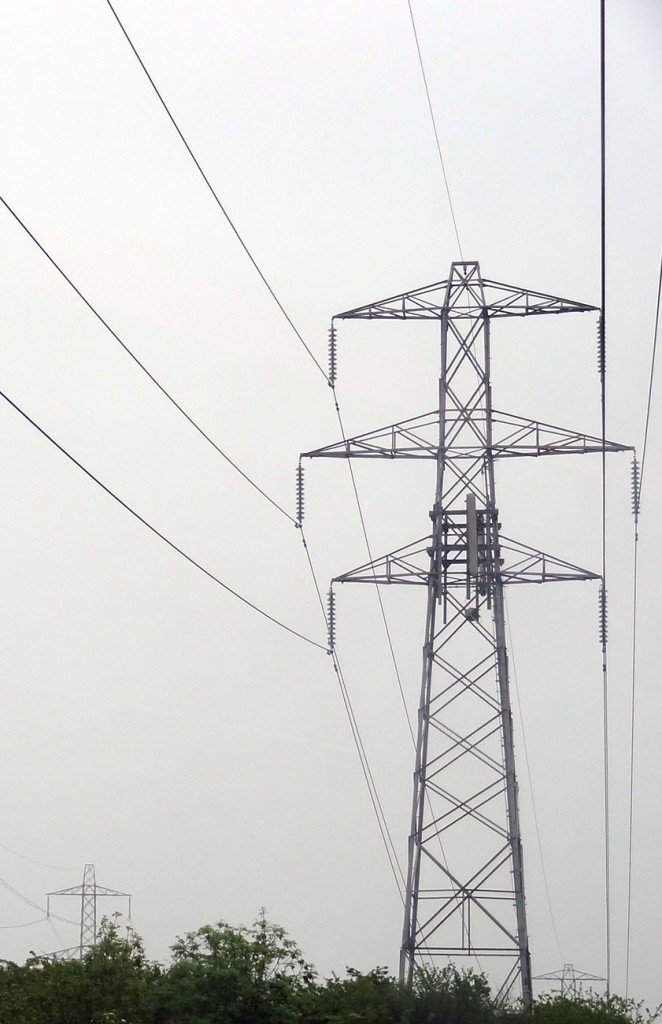 The energy sector has a history of criticism with regards to prices and practices. In the past, Ofgem have tried to make the sector more competitive, by ensuring that price comparisons are easier. At the beginning of this year, many of the big six providers announced price cuts, but within the next few weeks, we will see the reverse occurring, as energy prices begin to rise.
The energy sector has a history of criticism with regards to prices and practices. In the past, Ofgem have tried to make the sector more competitive, by ensuring that price comparisons are easier. At the beginning of this year, many of the big six providers announced price cuts, but within the next few weeks, we will see the reverse occurring, as energy prices begin to rise.
British Gas has announced price rises of 6% from 16th November that will affect over 8 million customers by adding approximately £80 per year to the annual dual fuel bill. Npower will also put its prices up 10 days later (8.8% for gas and 9.1% for electricity), creating higher bills for 3 million people.
In January of this year, when we saw energy prices fall, it was not solely due to Ofgem’s findings. We had a relatively mild winter, which reduced the demand for energy and this fed into lower prices. As the winter now approaches once more, demand for energy will begin to increase, feeding into prices that are now higher.
Furthermore, the energy companies have said that a range of external factors are also adding to their costs and putting increasing pressure on them to increase their charges. Npower’s Chief Commercial Officer said:
“There is never a good time to increase energy bills, particularly when so many people are working hard to make ends meet…But the costs of new statutory schemes, increases in distribution charges and the price of gas for the coming winter are all being driven up by external factors, for example government policy”
 Significant investment is needed in the energy sector. Energy companies are required to set aside money for maintaining and improving the national grid and investing in renewable energy, such as wind and solar power. In order for the energy companies to fund these investments, more money must be raised and the logical method is to put up prices. However, critics are simply blaming ‘these very big lazy companies’ who are passing ‘above-inflation price rises’ onto already squeezed households.
Significant investment is needed in the energy sector. Energy companies are required to set aside money for maintaining and improving the national grid and investing in renewable energy, such as wind and solar power. In order for the energy companies to fund these investments, more money must be raised and the logical method is to put up prices. However, critics are simply blaming ‘these very big lazy companies’ who are passing ‘above-inflation price rises’ onto already squeezed households.
Part of this is undoubtedly to do with the market structure of this sector. A typical oligopoly creates a market which, under certain circumstances, can be highly competitive, but because of barriers to entry that prevent new firms from entering the market may charge higher prices and be inefficient. Indeed, Ofgem has plans to reduce the power of the main energy providers by forcing them to auction off some of the electricity they generate. The aim of this is to free up the market and make it more competitive.
While only three providers have announced price rises, it is inevitable that the other three will follow. The relative increases will create incentives for consumers to switch providers, but crucial to this is an ability to understand the different tariffs on offer and lack of clarity on this has been a big criticism previously levelled at the energy sector. Indeed, half of UK customers have never switched energy providers. Perhaps this is the time to think about it, firstly as a means of saving money and secondly as a means of putting the energy companies in competition with each other. The following articles consider this market.
Energy price rises: how to switch, save and safeguard your supply The Guardian, Mark King (12/10/12)
 Npower and British Gas raise energy prices (including video) BBC News (12/10/12)
Npower and British Gas raise energy prices (including video) BBC News (12/10/12)
Energy price rises? We’re like turkeys voting for Christmas The Telegraph, Rosie Murray-West (12/10/12)
British Gas and Npower to raise prices fuelling fears of a ‘long, cold winter’ for more households Independent
, Graeme Evans (12/10/12)Wholesale prices rise as energy costs jump Wall Street Journal, Sarah Portlock and Jeffrey Sparshott (12/10/12)
British Gas raises gas and electricity prices by 6pc The Telegraph (12/10/12)
Osborne warns energy firms over price hikes Reuters (12/10/12)
Energy price hikes to take effect from next week Independent, Simon Read(13/10/12)
Questions
- What are the main reasons influencing the recent price rises? In each case, explain whether it is a demand- or supply-side factor.
- Using your answer from question 1, illustrate the effect of it on a demand and supply diagram.
- Which features of an oligopolistic market are relevant to the energy sector. How can we use them to explain these higher prices.
- How has government policy affected the energy sector and energy prices?
- Why are customers reluctant to change energy providers? Does this further the energy company’s ability to raise prices?
- Are there any government policies that could be implemented to reduce the power of the energy companies?
 Last year, an academic discovered that the only two firms on Amazon selling new copies of a classic biology textbook were charging well over $1 million (plus $3.99 for shipping!). Furthermore, when he checked the next day, prices had risen even further to nearly $2.8 million! Intrigued by this strange pricing behaviour, he started to investigate the prices further.
Last year, an academic discovered that the only two firms on Amazon selling new copies of a classic biology textbook were charging well over $1 million (plus $3.99 for shipping!). Furthermore, when he checked the next day, prices had risen even further to nearly $2.8 million! Intrigued by this strange pricing behaviour, he started to investigate the prices further.
In oligopoly markets with a small number of players, firms must make strategic decisions taking into account how they expect their rivals will react. One option in today’s online market places is for firms to use computer algorithms which automatically adjust their prices according to the prices their rivals are charging. The results of his investigation suggested that this was exactly what was causing the prices for this textbook to be so high.
One of the firms appeared to adopt a pricing rule which set its price at 0.9983 times the price of the other firm. This seems to make sense – this firm wants to undercut its rival in order to be more likely to sell its copy. However, if both firms operated under this strategy, we would expect to see prices falling over time (see also). In contrast, the strategy of the other firm appeared to be to price 1.270589 above its rival’s price. Why would it want to try to make sure it was always more expensive that its rival? The academic’s plausible explanation was that:
“…they do not actually possess the book. Rather, they noticed that someone else listed a copy for sale, and so they put it up as well – relying on their better feedback record to attract buyers. But, of course, if someone actually orders the book, they have to get it – so they have to set their price significantly higher – say 1.27059 times higher – than the price they’d have to pay to get the book elsewhere.”
Put both of these pricing rules together and prices will continuously rise over time! This was exactly what the academic observed for over a week, until human intervention appears to have returned prices to a more sensible level.
As Tim Harford discusses in his recent blog post, it had been hoped that online market places would result in very low prices because the high degree of price transparency increases competition. Clearly the prices Amazon was initially charging for the textbook didn’t support this theory and even after human intervention prices would seem to be well above marginal production costs. However, as the blog post goes on to explain, we should not necessarily expect price transparency always to lead to low prices. Economic theory shows us that in oligopoly markets, when a small number of players interact repeatedly, they may be able to collude tacitly on high prices. Furthermore, a high degree of price transparency may help such collusive behaviour because it makes it easier for firms to detect cheating by a rival.
Amazon’s $23,698,655.93 Book About Flies (SCREENSHOT) The Huffington Post, Steven Hoffer (26/04/11)
Questions
- What are the key features of competition between book sellers on Amazon?
- What price setting rule would the two firms have to use for prices to continuously fall over time? Provide an illustrative example.
- What are the pros and cons for a firm of relying on a computer algorithm to set its prices?
- How might a firm program its price setting algorithm if it wanted to collude tacitly with its rivals?
- Can you think of any other explanations for the pricing strategies that the two Amazon sellers adopted?
 In 2009, the European Commission investigated Microsoft’s practice of bundling its own browser, Internet Explorer, with new copies of Windows. It found that this was an abuse of market power and created an unfair barrier to entry of other browsers, such as Firefox.
In 2009, the European Commission investigated Microsoft’s practice of bundling its own browser, Internet Explorer, with new copies of Windows. It found that this was an abuse of market power and created an unfair barrier to entry of other browsers, such as Firefox. For this lapse, the Commission has just fined Microsoft €561m. Commission Vice President in charge of competition policy, Joaquín Almunia, said:
For this lapse, the Commission has just fined Microsoft €561m. Commission Vice President in charge of competition policy, Joaquín Almunia, said: This may seem unduly harsh, given that Internet Explorer’s share of the browser market has fallen dramatically. In 2009, it had around 50% of the European market, with its main rival at the time, Mozilla’s Firefox, having just under 40%. By 2013, Internet Explorer’s share has fallen to around 24% and Firefox’s to around 29%. Google’s Chrome, which was just starting up in 2009, has seen its share of the European market rise to around 35% and is now the market leader. Partly this is due to the rise in tablets and smartphones, a large proportion of which use Google’s Android operating system and the Chrome browser.
This may seem unduly harsh, given that Internet Explorer’s share of the browser market has fallen dramatically. In 2009, it had around 50% of the European market, with its main rival at the time, Mozilla’s Firefox, having just under 40%. By 2013, Internet Explorer’s share has fallen to around 24% and Firefox’s to around 29%. Google’s Chrome, which was just starting up in 2009, has seen its share of the European market rise to around 35% and is now the market leader. Partly this is due to the rise in tablets and smartphones, a large proportion of which use Google’s Android operating system and the Chrome browser. EU commissioner Joaquin Almunia announces Microsoft fine BBC News (6/3/13)
EU commissioner Joaquin Almunia announces Microsoft fine BBC News (6/3/13)






